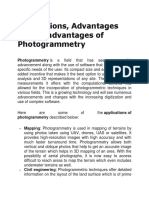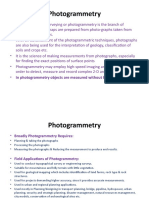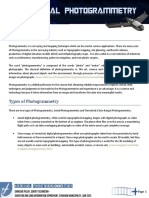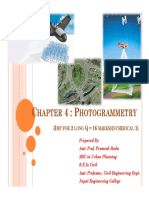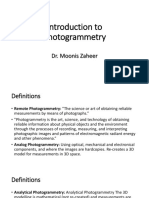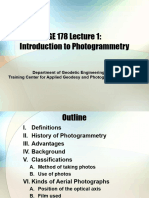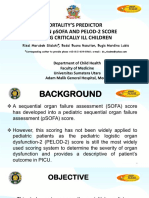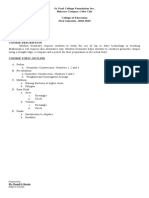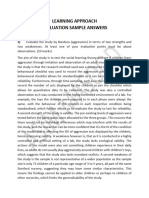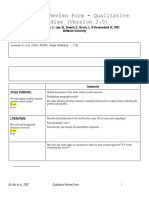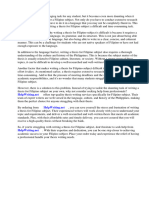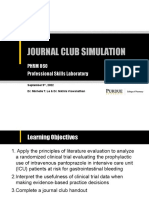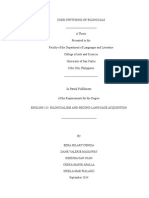Experiment No.
1
INTRODUCTION TO PHOTOGRAMMETRY
Aim: To understand the meaning of photogrammetry and to explain its classification and
significance.
Introduction:
Photogrammetry is the art, science, and technology of obtaining reliable information about physical
objects and the environment through processes of recording, measuring, and interpreting
photographic images and patterns of recorded radiant electromagnetic energy and other
phenomena. In simple terms, Photogrammetry is the art of making reliable measurements from the
air photographs. The name “photogrammetry" is derived from the three Greek words phos or phot
which means light, gramma which means letter or something drawn, and metrein, the noun of
measure. Photogrammetry is nearly as old as photography itself since its development.
Principle of Photogrammetry: The principles of Photogrammetry come from the understanding of
how Human eyes work. The fundamental principle used by photogrammetry is triangulation. By
taking photographs from at least two different locations, so-called “lines of sight” can be developed
from each camera to points on the object. These lines of sight (sometimes called rays owing to their
optical nature) are mathematically intersected to produce the 3-dimensional coordinates of the points
of interest. Triangulation is also the principle used by theodolites for coordinate measurement. There
are many similarities (and some differences) between photogrammetry and theodolites. Even closer
to home, triangulation is also the way your two eyes work together to gauge distance (called depth
perception).
Photogrammetry Workflow:
A standard workflow of Photogrammetry contains three main phases which are: 1) Data Acquisition,
2) Photogrammetric Procedures and 3) Photogrammetric Products.
Types of Photogrammetry:
Photogrammetry can be broadly classified into aerial photogrammetry and terrestrial
Photogrammetry based on Camera Position. Aerial photogrammetry uses images taken from aircraft,
while terrestrial photogrammetry uses images captured from ground-based positions. Further
classifications exist within these categories, such as analog, analytical, and digital photogrammetry
for aerial photogrammetry.
Analog Photogrammetry: This older method uses physical, film-based photographs and
analog instruments for measurements and calculations.
Analytical Photogrammetry: This approach utilizes computers to process images, but still
relies on the physical properties of the photographs.
� Digital Photogrammetry: This modern method uses digitally acquired images and
specialized software for measurement and analysis.
Based on Application - Photogrammetry is classified into Metric and Interpretative. Metric
photogrammetry consists of making precise measurements from photos and other information
sources to determine, in general, the relative locations of points. This enables finding distances,
angles, areas, volumes, elevations, and sizes and shapes of objects. The most common applications
of metric photogrammetry are the preparation of planimetric and topographic maps from
photographs through. Interpretative Photogrammetry deals principally in recognizing and identifying
objects and judging their significance through careful and systematic analysis.
Advantages of Photogrammetry Advantages:
1. Photos provide a permanent record of the existing terrain conditions at the time the photograph
was taken.
2. Photos can be used to convey information to the general public, and other federal, state, or local
agencies.
3. Photos can be used for multiple purposes within CDOT such as reconnaissance, preliminary
design, environmental, and Right of Way.
4. Topographic mapping and DTMs of large areas can be accomplished relatively quickly and at a
lower cost when compared to ground survey methods.
5. Photogrammetry can be used in locations that are difficult or impossible to access from the
ground.
Disadvantages of Photogrammetry:
1. Seasonal conditions, including weather, vegetation, and shadows can affect both the taking of
photographs and the resulting measurement quality. If the ground is not visible in the photograph it
cannot be mapped.
2. Overall accuracy is relative to camera quality and flying height. Elevations derived from
photogrammetry are less accurate than ground surveys (when compared to conventional or GPS
ground survey methods using appropriate elevation procedures).
3. Identification of planimetric features can be difficult or impossible (e.g., type of curb and gutter,
size of culverts, type of fences, and information on signs).
4. Underground utilities cannot be located, measured, or identified.
5. Right of Way and property boundary monuments cannot be located, measured, or identified.
6. Since photogrammetric features are compiled from a plan view, buildings are measured around
overhangs and eaves rather than at building footprints, resulting in some areas of DTM occlusion
under overhangs, eaves, and overhead walkways. Areas under bridges are similarly affected.
Applications of Photogrammetry: Photogrammetry has been used in various fields such as the
following:
Topographic Mapping: Photogrammetry is a core technique for creating detailed topographic
maps, including elevation models and contour lines, essential for land development and urban
planning.
Engineering and Construction: It's used to survey buildings and structures, monitor
engineering components, and even calculate earthwork quantities for construction projects.
Land Use Planning: Photogrammetry provides valuable data for analyzing land use, forest
management, and environmental studies.
Geological Surveys: Photogrammetry aids in mapping geological formations, assessing
mineral resources, and monitoring landslides.
� Forensic Documentation: Photogrammetry is used to document crime scenes, evidence,
and injuries with high accuracy.
Medical Imaging: It helps in recording skin lesions, measuring body parts, and creating 3D
models of internal organs for research and clinical purposes.
Archaeological Documentation: Photogrammetry is used to record and preserve
archaeological sites, artifacts, and underwater sites.
Forestry: Photogrammetry is used to assess forest health, measure tree heights, and map
forest areas.
Manufacturing: It aids in quality control, reverse engineering, and creating 3D models of
manufactured products.
Precision Agriculture: Photogrammetry can be used to monitor crop health, assess
irrigation needs, and predict agricultural production.
Entertainment and Gaming:
3D models created using photogrammetry are used in creating realistic environments for
games and movies.

